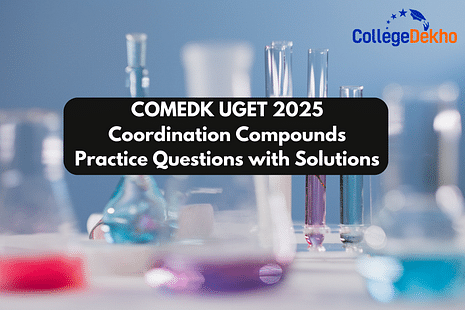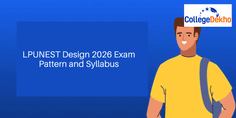
COMEDK UGET 2025 Coordination Compounds Practice Questions with Solutions: The Coordination Compounds chapter carries substantial weight in the COMEDK UGET syllabus and is a crucial topic in Chemistry. The COMEDK UGET 2025 Coordination Compounds practice questions will encompass essential concepts such as Coordination number, Colour, Magnetic properties and shapes, IUPAC nomenclature of mononuclear coordination compounds, and Bonding. With an expected 10-20 questions in the COMEDK UGET 2025 exam , mastering this topic can significantly enhance your overall Chemistry score. Since the COMEDK 2025 syllabus includes concepts from both 11th and 12th standard, it is vital to go beyond memorization and engage in consistent practice. Solving COMEDK UGET Coordination Compounds sample questions will help you familiarize yourself with the question types, difficulty level, and exam pattern, improve problem-solving speed and accuracy, strengthen conceptual understanding and numerical applications, and recognize key frequently asked questions. This article will provide COMEDK UGET 2025 Coordination Compounds practice questions along with solutions to aid in effective preparation and maximize your chances of achieving a high score in the exam.
Also Check -
Do or Die Chapters for COMEDK UGET 2025 Chemistry
Quick Links:
COMEDK UGET 2025 Coordination Compounds Important Topics
There are various topics that are included in the Coordination Compounds chapter, such as Structure and stereoisomerism, Werner’s theory, Bonding etc. If you are planning to sit for the exam, then you must make sure to be well-versed in all the topics properly. You can find the detailed list of COMEDK UGET 2025 Coordination Compounds sub-topics for exam preparation below:-
Chapter | Topics |
|---|---|
Coordination Compounds |
|
Also Check - COMEDK Chapter Wise PYQs for Chemistry
COMEDK UGET 2025 Coordination Compounds Expected Weightage
As previously discussed, the Coordination Compounds chapter holds nearly 33% weightage in the COMEDK UGET 2025 Chemistry syllabus . While preparing, it is essential to have a clear understanding of both the expected weightage and the number of questions likely to be asked from this chapter. The table below provides a concise summary of the key details regarding the COMEDK UGET 2025 Coordination Compounds expected weightage.
Topic | Expected Number of Questions | Expected Weightage |
|---|---|---|
Coordination Compounds | 10-20 | 16-33% |
Quick Links:
COMEDK UGET 2025 Coordination Compounds Practice Questions with Solutions
Consistently practicing COMEDK Coordination Compounds sample questions can greatly improve your exam preparation. COMEDK UGET 2025 Coordination Compounds practice questions with solutions helps you become familiar with possible exam questions, verify correct answers, and grasp step-by-step solutions effectively. Below are some important COMEDK UGET 2025 Coordination Compounds practice questions, carefully curated from past exam papers.
Q1. Which among the following is diamagnetic?
a) [Ni(CN)4] 2-
b) [CO(F6)] 3-
c) [NICL4] 2-
d) [Fe(CN)6] 3-
Correct answer - a) [Ni(CN)4] 2-
Solution: In [Ni(CN)4] 2- is strong field ligand and causes pairing of electrons.
Therefore, Ni2+ = 3d8
[Ni(CN) 4 ] 2-
Q2. The complex [PtCl 2 (en) 2 ] 2+ ion shows
a) structural isomerism
b) geometrical isomerism only
c) optical isomerism only
d) geometrical and ooptical isomerism
Correct answer - d) geometrical and ooptical isomerism
Solution: [PtCl 2 (en) 2 ] 2+ shows both geometrical and optical isomerism at the complex forms sis and trans isomers. Trans-isomer doesn’t show optical isomerism since it is symmetrical but cis-isomer shows optical isomerism as it is unsymmetrical.
Q3. Aqueous CuSO 4 changes colour from sky blue to deep blue on addition on NH3 because:
a) Cu 2+ forms hydrate
b) Cu 2+ changes to Cu +
c) [Cu(H 2 O) 4 ] 2+ + is labile complex and changes to [Cu(NH 3 ) 4 ] 2+ as NH3 is stronger ligand than H 2 O
d) Cu + changes to Cu 2+
Correct answer - c) [Cu(H 2 O) 4 ] 2+ is labile complex and changes to [Cu(NH 3 ) 4 ] 2+ as NH3 is stronger ligand than H 2 O
Solution: As H 2 O is a weak field ligand and thus [Cu(H 2 O) 4 ] 2+ absorbs red light in visible spectrum. But the colour appears blue because [Cu(H 2 O) 4 ] 2+ is a liblie complex and changes to [Cu(H 2 O) 4 ] 2+ , where NH3 is a strong field ligand thus absorbs yellow light of visible spectrum and impart blue oclour.
Q4. Identify the correct IUPAC name of [CoCl 2 (NO 2 )(NH 3 ) 3 ]
a) Triamminedichloridonitrito-N- cobalt (III)
b) Dichloridotriamminenitrito-O-cobaltate(II)
c) Dichlorotriamminenitrito- N - cobalt(OO)
d) Triamminedichloronitrito-O-cobaltate(III)
Correct answer - a) Triamminedichloridonitrito-N- cobalt (III)
Solution: The correct IUPAC name for the complex [CoCl2(NO2)(NH3)3] can be determined by following the rules for naming coordination compounds:
Ligands are named first in alphabetical order before the metal ion is named. Here, ammine (old spelling of amine recommended by IUPAC for naming complexes) comes before chloro and nitrito. Remember, nitrito can bind through the nitrogen (N) or through one of its oxygens (O), which will be specified as nitrito-N or nitrito-O,
The prefixes di-, tri-, etc., are used to indicate the number of each type of ligand in the complex, but these prefixes do not affect the alphabetical order.
The metal's oxidation state is indicated in parentheses using Roman numerals after the name of the metal.
If the complex is an anion, the suffix "-ate" is added to the name of the metal. However, since cobalt is not in anionic form here, we don’t add "-ate" to cobalt.
The charge of the complex can be determined for naming purposes, but it does not directly affect the choice among these options since they all refer to cobalt with Roman numerals to represent its oxidation state.
In this complex, cobalt (Co) is the central metal ion, and its oxidation state needs to be determined. Considering the ligands, we have two chloro (Cl - ) igands, one nitrito ligand that we need to establish is binding through nitrogen for certain options, and three ammine (NH 3 ) ligands.
To determine the oxidation state of Co, recall that NH3 is a neutral ligand, Cl - has a -1 charge each, making a total of -2 from the chlorides, and assuming nitrito as a monodentate ligand, it does not impact the calculation of the oxidation state as it's also considered to have a -1 charge when bound. The complex is neutral, so:
x+3(0) + 2 (-1) + (-1) = 0
X-3 = 0
So, cobalt is in the +3 oxidation state, making our choice among those mentioning cobalt(III).
The correct IUPAC name, therefore, comes from ordering the ligands alphabetically (ammine before chloro and nitrito), indicating the ligand count (triammine for three NH 3 , dichloro for two Cl - ), and specifying how nitrito is bound if specified how nitrito is bound if specified (nitrito-N or nitrito - )). Since none of the names mention the nitrito binding as O-bound and we don't have evidence from the provided formula to assume it binds through oxygen, the choice defaults to either directly listing nitrito or specifying as nitrito-N if such specification is given.
Considering all of the above, the correct option is:
Option A: Triamminedichloridonitrito-N- cobalt (III) because it follows the correct naming order, indicates the oxidation state accurately, and specifies the ligand connections correctly for a neutral complex.
Q5. Which one of the following Coordination entities exhibits Facial and Meridional isomerism?
a) [Co(H 2 O) 3 (NO 2 ) 3 ]
b) [CO(en) 2 Cl 2 ] +
c) [Co(NH 3 ) 4 Br 2 ]NO 3
d) [Co(en) 3 ]Cl 3
Correct answer - a) [Co(H 2 O) 3 (NO 2 ) 3 ]
Solution: The phenomenon of facial and meridional isomerism occurs in octahedral complexes with a general formula of the type MA 3 B 3 , where A and B are different sets of bidentate or monodentate ligands. This type of isomerism describes the distinct arrangement positions these ligands can adopt relative to each other in the geometry of the complex.
Facial (fac) isomerism occurs when the three identical ligands occupy adjacent positions at the corners of one face of the octahedron, forming a triangle. This can be thought of as the three A ligands or three B ligands clustering on the same face of the octahedral structure.
Meridional (mer) isomerism, on the other hand, is characterized by the arrangement where the three identical ligands lie along a meridian roughly forming a vertical band that includes the metal center. This isomer has the three A ligands or three B ligands spread out, each occupying a vertex of a plane that cuts through the center of the octahedron and divides it into two equal halves.
Examining the options provided:
Option A : [Co(H 2 O) 3 (NO 2 ) 3 ] is an octahedral complex where we have three molecules of water and three nitro groups as ligands. This type of complex has the general formula MA 3 B 3 and thus can exhibit both facial and meridional isomerism, making it a possible answer.
Option B : [CO(en) 2 Cl 2 ] + does not fit the required general formula MA 3 B 3 because it contains two ethylenediamine (en) ligands and two chloride ions. This complex is also more suitable to show geometrical isomerism (cis/trans).
Option C : [Co(NH 3 ) 4 Br 2 ]NO 3 does not fit MA 3 B 3 formula either, as it has four ammonia and two bromide ligands, making it suitable for other types of isomerism like cis-trans but not facial or meridional.
Option D : [Co(en) 3 ]Cl 3 does not fit the formulation criterion MA 3 B 3 , it is a complex with three identical chelate rings (triethylenediamine ligands), and symmetry precludes it from fac or mer isomerism.
Conclusion : Among the options, Option A [Co(H 2 O) 3 (NO 2 ) 3 ] is the only complex capable of exhibiting both facial and meridional isomerism due to its meeting the MA3B3 configuration criteria. The other options do not conform to this requirement and thus cannot exhibit these specific types of isomerism.
Related Articles
Are you feeling lost and unsure about what career path to take after completing 12th standard?
Say goodbye to confusion and hello to a bright future!

Was this article helpful?





















Similar Articles
GATE CS Question Paper Difficulty Level Trends: A detailed analysis
JEE Main 2026 Chemistry High Priority and Low Priority Chapters
Are JEE Main Study Groups Worth It? Detailed Pros and Cons for 2026 Aspirants
How to Prioritize Physics Chapters Based on JEE Main 2026 Weightage and Difficulty
GATE 2026 Mechanical Engineering Expected No. of Questions Topic-Wise
GATE 2026 Civil Engineering Expected No. of Questions Topic-Wise